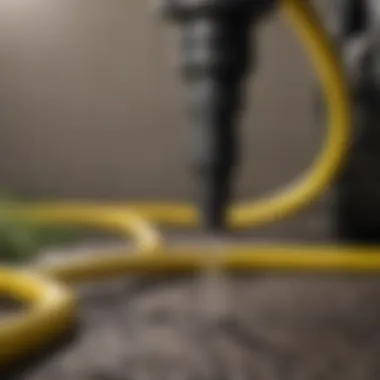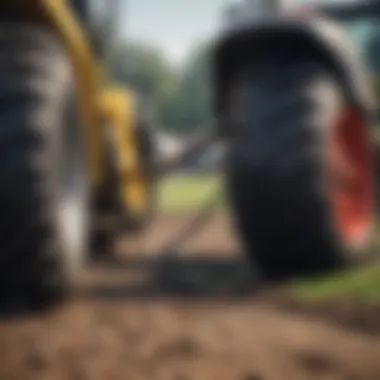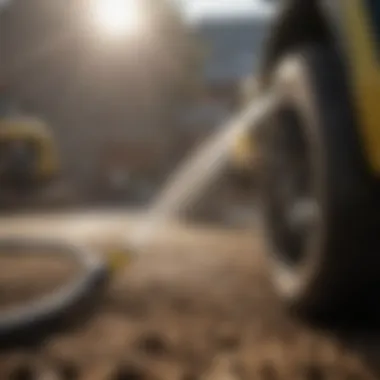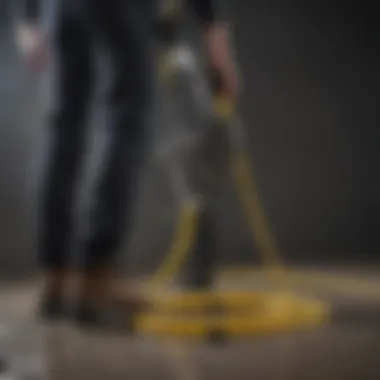Understanding Karcher Connecting Hose: Features & Uses


Intro
The Karcher connecting hose plays a significant role in agriculture and horticulture, enabling efficient water transportation for various applications. Understanding its features, materials, and specifications is vital for professionals in these fields. This article aims to provide in-depth insights that help users select the right hose and utilize it effectively.
Overview of the Topic
Definition and Importance
A connecting hose is designed to link equipment, allowing water flow from one device to another. Karcher, as a reputable brand in the field, manufactures hoses that cater to both the needs of farmers and horticulturists. These hoses are essential for properly irrigating crops, maintaining gardens, and carrying out various agricultural tasks. The right connecting hose can significantly impact productivity and resource management.
Current Trends
Today, there is an increased focus on sustainable practices in agriculture. Karcher has responded to this trend by creating hoses made from eco-friendly materials. The demand for efficient water management systems is also rising. The Karcher connecting hose meets these needs, offering durability and compatibility with various systems.
Key Techniques and Practices
Step-by-Step Guide
- Selecting the Proper Hose: Understand the specific requirements of your equipment. Consider length, diameter, and material of the hose.
- Installation: Ensure all connections are secure. Check for leaks to prevent water loss.
- Maintenance: Regularly inspect for wear and tear. Replace damaged sections promptly.
- Storage: Store the hose in a cool, dry place when not in use to prolong its lifespan.
Tools and Equipment Needed
- Karcher connecting hose
- Hose connectors
- Hose clamps
- Repair kits (for punctures)
- Storage reels
Challenges and Solutions
Common Obstacles
One challenge faced by users is ensuring compatibility with various attachments. Users may also struggle with kinks in the hose which can disrupt water flow.
Innovative Solutions
To enhance compatibility, Karcher provides a range of adapters. For kinks, selecting a hose that is designed for flexibility is advisable. Additionally, utilizing hose trays can help maintain the shape and integrity of the hose when in use.
"Proper selection and maintenance of hoses can lead to significant savings in water usage over time."
End
Prolusion to Karcher Connecting Hose
Karcher connecting hoses serve as a vital link in the operation of various agricultural and horticultural tools. Understanding these hoses is crucial for professionals seeking efficiency and reliability in their tasks. The connecting hose is not merely a conduit for water; it plays a significant role in how equipment functions, influencing productivity and outcomes in farming operations. This article will explore the specific elements, benefits, and considerations regarding Karcher connecting hoses.
Overview of Karcher Products
Karcher is a recognized brand in the realm of cleaning and watering solutions, including high-pressure washers, water pumps, and a range of accessories. Their connecting hoses are designed to enhance compatibility with these devices. Different models of Karcher hoses are available to meet various agricultural needs. Such products integrate seamlessly to ensure high performance and durability.
Some of the Karcher products that utilize connecting hoses include:
- Karcher K5 Pressure Washer: Ideal for medium-duty tasks, suitable for cleaning dirt and grime effectively.
- Karcher Water Pumps: Helpful in irrigation and keeping your garden well-watered.
- Karcher K1700: This device also showcases how proper hose connections enhance functionality.
Investing in quality Karcher hoses is essential for anyone relying on such equipment in their daily tasks.
Importance of Connecting Hoses in Agriculture
In agriculture, the connection between equipment and water supply is fundamental. Connecting hoses allow for the efficient transfer of water, vital for irrigation and equipment operations. They enable farmers to water crops, clean machinery, and ensure their tools operate at peak performance. Without proper hoses, equipment can experience malfunctions due to inadequate water supply.
"The right connecting hose can mean the difference between efficient work and frustrating downtime."
Benefits of using Karcher connecting hoses in agriculture include:
- Enhanced Efficiency: Proper hoses help maintain consistent water flow to tools, promoting effective cleaning and watering.
- Durability: Karcher hoses are built to endure the rigors of farm environments, providing reliability over time.
- Adaptability: These hoses work with various Karcher devices, facilitating versatility in their use.


In summary, understanding Karcher connecting hoses is fundamental for agricultural professionals aiming to optimize their operations. Their role is not limited to being a mere accessory but is integral to the functionality and efficiency of agricultural tools.
Specifications of Karcher Connecting Hose
Understanding the specifications of the Karcher connecting hose is vital for maximizing its effectiveness in agricultural applications. These specifications link directly to the hose's compatibility, performance, and usability across different devices and scenarios. Recognizing the material composition and technical dimensions provides insights into the advantages these hoses offer to professionals working in agriculture and horticulture.
Material Composition
Durability Considerations
Durability is a critical factor in selecting a connecting hose. The Karcher connecting hose is constructed from high-quality materials that ensure longevity even in rigorous environments. The main characteristic that sets it apart is its ability to withstand high pressure. This is beneficial for farmers who frequently use pressure washers or pumps, as they need a hose that will not rupture under strain. A unique feature of this durability is the reinforcement layer typically included in these hoses, which enhances their strength and resistance to wear and tear. However, it's worth considering that while highly durable, the robustness may make the hose slightly heavier compared to more flexible options.
Resistance to Environmental Factors
Resistance to environmental factors plays a crucial role in the longevity and effectiveness of the Karcher connecting hose. This hose is designed to resist ultraviolet rays, extreme temperatures, and chemical exposure. The key characteristic here is its ability to maintain performance despite varying environmental conditions. This makes it a popular choice for outdoor agricultural use. For example, a unique feature is the protective coating that helps prevent degradation, ensuring that the hose remains effective over time. Nonetheless, such coatings may require more meticulous cleaning procedures to avoid buildup, which can affect performance.
Technical Dimensions
Length Variations
Length variations of the Karcher connecting hose are important in tailoring solutions to specific tasks within agriculture. Different lengths allow for greater flexibility in operation, enabling users to reach distant areas without needing additional extensions. The most notable aspect of these variations is the adaptability they provide, allowing farmers to choose lengths that suit their equipment and landscape. A unique feature is that these hoses are often available in standardized lengths, which can facilitate the purchase decisions for users. One minor disadvantage could be that some users might find longer hoses more difficult to manage or store.
Diameter Specifications
Diameter specifications also significantly influence functionality. The Karcher connecting hose comes in various diameters suitable for different devices. The key characteristic to highlight is the flow rate capability, which relates directly to the diameter of the hose. Larger diameters facilitate higher flow rates, which can be advantageous for rapid irrigation or cleaning tasks. A unique aspect is the option to select specific diameters for specific applications, enhancing performance efficiency. However, this may confound some users if they are unsure which diameter is most appropriate for their needs, potentially leading to suboptimal performance.
Compatibility and Usage
Understanding the compatibility and usage of Karcher connecting hoses is vital. This section will explore how these hoses integrate with Karcher devices. Knowing this information can enhance operational efficiency and decision-making in agricultural practices.
Compatible Karcher Devices
Pressure Washers
Pressure washers are essential tools in various cleaning tasks. They provide powerful water jets that can remove dirt, grime, and other debris. The Karcher connecting hose is specifically designed to work seamlessly with their range of pressure washers.
The main characteristic of pressure washers is their efficiency in delivering high-pressure water. This feature makes them a favorable option for professionals who demand quick and effective cleaning. The connecting hose enhances this capability by ensuring a steady flow of water to the machine, thus optimizing cleaning performance.
One unique feature of pressure washers is their adjustable pressure settings. This functionality allows users to control the intensity of the water stream based on the task. However, some users may find it challenging to maintain compatibility with older hose models. As technology progresses, newer models may require specific hose designs or fittings for optimal performance.
Water Pumps
Water pumps are crucial in agricultural settings as they facilitate the movement of water for irrigation and other applications. The Karcher connecting hose is suitable for use with their water pumps, ensuring effective water flow.
The key characteristic of water pumps is their ability to transport large volumes of water efficiently. This makes them ideal for extensive irrigation systems, where a constant supply of water is necessary. The connecting hose plays a significant role in this process, linking the pump to the water source or distribution point.
A key feature of Karcher water pumps is their energy efficiency. They are designed to minimize electricity consumption while maximizing water output. This results in lower operational costs over time. However, some users might experience issues with hose compatibility, especially when utilizing multiple equipment from different manufacturers.
General Applications in Agriculture
Irrigation Systems
Irrigation systems are a fundamental aspect of modern agriculture. They ensure that crops receive the necessary water, fostering growth and maximizing yields. The Karcher connecting hose is equipped to support various types of irrigation systems.
The primary characteristic of irrigation systems is their efficiency in delivering water to crops. A Karcher connecting hose minimizes water wastage by maintaining consistent pressure and flow rates. This feature amplifies its importance in achieving effective irrigation, especially in regions with limited water supply.
One unique advantage of using Karcher hoses in irrigation systems comes from their durability. They can withstand high pressures and are resistant to various environmental factors, ensuring long-term use. However, attention must be paid during installation, as improper connections may lead to leaks or malfunctions.
Equipment Washing
Equipment washing is vital for maintaining agricultural machinery. Keeping equipment clean enhances performance and longevity. Karcher connecting hoses are designed to facilitate efficient washing processes.


The essential characteristic of equipment washing is its role in preventive maintenance. Regular cleaning can minimize wear and tear on machinery, leading to higher efficiency and reduced downtime. By using a Karcher connecting hose, farmers can connect their washers directly to water sources, streamlining the cleaning process.
A notable feature of Karcher washing solutions is their compatibility with different hose lengths. This versatility allows users to access hard-to-reach areas. However, it is important to ensure that the hose is appropriate for the chosen washing equipment to avoid issues with pressure loss.
Installation and Setup
Installation and setup of the Karcher connecting hose is a critical step that determines its functionality and longevity. A well-executed installation ensures that the hose operates efficiently and minimizes potential problems. Farmers and enthusiasts alike benefit from understanding how to connect their hoses properly. Knowledge in this area aids in preventing leaks, ensuring maximum water flow, and protecting equipment. Therefore, the time taken to install the hose correctly pays dividends in performance.
Connecting the Hose to Devices
Step-by-Step Process
The step-by-step process for connecting the Karcher hose to devices is straightforward, yet vital. To start, it usually involves selecting the appropriate connectors that fit both the hose and the device being used. Here’s how to effectively connect the hose:
- Choose the Right Connector: Ensure the connector matches the device’s inlet.
- Clean the Inlet: Make sure the inlet is free from debris to avoid blockages.
- Align the Hose: Position the hose so it fits snugly against the inlet.
- Secure the Connection: Turn the connector clockwise until it feels snug.
- Test for Leaks: Turn on the device and check for any leaks.
This process is valuable for its ease and effectiveness. One key characteristic is its focus on simplicity and reliability. By following this process, users can ensure that their connecting hose performs optimally. A unique feature of this step-by-step method is it emphasizes preparation, which can lead to significantly fewer operational issues.
Common Mistakes to Avoid
When connecting the hose, there are common mistakes that can impact functionality. Understanding them is essential to protect your equipment and maximize efficiency. A few prevalent issues include:
- Over-tightening Connections: This can cause damage to the fittings or even lead to leaks.
- Using Improper Connectors: Not all connectors are interchangeable, which may cause malfunctions.
- Neglecting to Clean the Inlet: Any obstruction can reduce flow and pressure, affecting performance.
Recognizing these common pitfalls is beneficial for a better operational experience. The focus here is on preventative measures that can spare users both time and cost. A unique feature of this section is its ability to guide users toward best practices in hose management. This knowledge helps avoid future complications.
Securing Connections
Types of Connectors
The type of connectors used in conjunction with the Karcher connecting hose can influence the effectiveness of water flow and hose durability. Different types include quick-connect fittings, threaded connectors, and bayonet fittings. Quick-connect fittings, particularly, are favored for their ease of use. They allow for rapid attachment and release, which is advantageous for tasks requiring frequent hose changes.
However, a potential disadvantage of some connectors is that they may not provide the same level of durability as threaded types, especially in high-pressure scenarios. Thus, a deep understanding of connector types is vital for optimizing performance and ensuring the longevity of the connecting hose.
Ensuring Leak-Proof Joints
Ensuring leak-proof joints is crucial in the installation of the Karcher connecting hose. A well-sealed joint prevents water loss and maintains pressure. The primary method for achieving this involves using high-quality sealing tape or O-rings. It is important to apply sealing tape in the right direction and to the correct length to ensure effectiveness.
This focus on leak-proofing is significant for any agricultural practice where water conservation is important. The unique feature of establishing leak-proof joints lies in its impact on overall system efficiency, reducing waste and downtime. A well-sealed joint not only enhances performance but also extends the life of the entire system.
"Investing time in proper installation and setup can yield substantial returns in efficiency and equipment longevity."
In summary, understanding installation and setup—including step-by-step processes and common mistakes—can dramatically improve the performance of the Karcher connecting hose. Securing connections with the right connectors and ensuring leak-proof joints are fundamental practices for effective usage in agriculture.
Maintenance of Karcher Connecting Hose
Maintaining the Karcher connecting hose is crucial for ensuring its longevity and effectiveness. Over time, wear and tear can occur, impacting performance. Proper maintenance helps to prevent costly repairs and downtime. A well-maintained hose not only works efficiently but also enhances overall productivity in agricultural tasks, making it an essential aspect of equipment management.
Regular Inspection Procedures
Identifying Wear and Tear
Identifying wear and tear in the Karcher connecting hose is vital. Regular checks can reveal cracks, abrasions, or other forms of damage that may compromise the hose's functionality. One key characteristic of this process is its proactive nature. Instead of waiting for a problem to escalate, inspection allows for timely intervention.
The unique feature of identifying wear and tear is its comprehensive approach. It considers various factors such as usage frequency, environmental exposure, and material fatigue. The advantage of this routine is the potential for early detection, which can save time and resources in the long run.
Preserving Hose Integrity
Preserving the integrity of the Karcher connecting hose is equally important. This involves consistently checking for leaks and ensuring all connections are secure. A key characteristic of this process is the emphasis on prevention. By maintaining hose integrity, users can avoid unexpected failures during critical tasks.
This unique feature is the use of high-quality connectors and fittings designed to maintain a reliable flow. The benefits of preserving hose integrity include reduced maintenance costs and improved operational efficiency. However, it requires diligence and regular attention to detail.


Cleaning and Care Techniques
Cleaning Solutions
Choosing effective cleaning solutions for the Karcher connecting hose heavily contributes to its maintenance. Certain cleaning agents can break down dirt and grime without damaging the material. A significant characteristic of suitable cleaning solutions is their ability to disinfect while being gentle on the hose material.
The unique feature of these solutions is their formulation, which is specifically designed for agricultural hoses. The advantage of using the right cleaning solutions is the prevention of buildup that can lead to blockages. On the downside, some harsh chemicals may deteriorate the hose, making careful selection essential.
Proper Drying Methods
Proper drying methods after cleaning are crucial for maintaining the Karcher connecting hose. Water left on the hose can lead to mold or mildew, which negatively impacts its lifespan. A key characteristic of effective drying methods is ensuring that the hose is completely dry before storage.
The unique feature of these methods is the use of airflow or sunshine, which are natural ways to dry the hose effectively. The main advantage of proper drying is the extended usability of the hose, while improper drying could result in costly replacements.
Troubleshooting Common Issues
Troubleshooting common issues with Karcher connecting hoses is critical to ensuring proper functioning and longevity of gardening and agricultural equipment. Identifying problems such as leaks and blockages can help maintain productivity and prevent potential damage to devices. In this section, we will discuss these common issues and introduce effective strategies that can be implemented to resolve them efficiently.
Identifying Problematic Signs
Leaks
Leaks can severely affect the performance of a Karcher connecting hose. They often occur due to wear, improper installation, or damages. A leak may not be immediately noticeable, but over time, it can lead to substantial water loss and reduced efficiency in irrigation systems. Recognizing a leak is crucial because it indicates that water is escaping before it reaches the intended destination.
Common indicators of leaks include:
- Visible water pooling around connections
- Damp spots or wet sections on the hose
- A noticeable drop in water pressure during use
The key characteristic of leaks is that they waste both water and resources, making timely detection and repair essential for effective agricultural practices. Leaks can also lead to further damage to the hose material if left unaddressed.
Blockages
Blockages represent another common issue that can hinder the functionality of Karcher connecting hoses. They typically occur when debris, sediment, or plant material obstructs the flow of water through the hose. Blockages can reduce water pressure and affect the entire irrigation system.
The importance of recognizing blockages lies in their potential to disrupt watering schedules and decrease the efficiency of agricultural operations. Signs that suggest a blockage could be present include:
- Lower water flow than expected
- Unusual noises coming from the hose line
- Sudden increase in pressure in parts of the hose
Identifying blockages allows for timely intervention, preventing bigger problems that might arise from stagnant water or other complications.
Resolution Strategies
Temporary Fixes
Temporary fixes often provide a quick solution to immediate problems, allowing agricultural tasks to continue with minimal interruption. These can include using tape to seal a small leak or removing the hose from a system to relieve a blockage. Temporary fixes are generally easy to implement and require little expertise. However, they should not be regarded as permanent solutions.
The advantage of temporary fixes is that they can immediately restore functionality. However, they might not address the root cause of the problem, leading to future issues. These fixes are best used in urgent situations while a more thorough solution is planned.
Long-Term Solutions
Long-term solutions involve addressing the underlying causes of problems like leaks and blockages to prevent recurrence. For instance, replacing worn connectors or regularly inspecting hoses can significantly reduce the likelihood of leaks. Additionally, implementing routine maintenance checks can help identify potential blockages.
These solutions take more time and effort to implement but provide lasting benefits. They contribute to the reliability and durability of Karcher connecting hoses. The upfront investment in these solutions often pays off through enhanced efficiency and reduced costs related to repairs.
"Investing in proper maintenance and timely repairs ensures that Karcher connecting hoses can function efficiently for years to come.”
The End
In this article, we have explored the Karcher connecting hose, a crucial element that supports a wide range of applications in agriculture and horticulture. The importance of this topic cannot be overstated. A well-functioning connecting hose enhances operational efficiency and productivity throughout various farming and gardening tasks.
Recap of Key Points
- Material and Durability: The Karcher connecting hose is engineered with high-quality materials to withstand wear and environmental challenges. Its durability promotes a long lifespan, which is vital for economic viability.
- Compatibility: Understanding which Karcher devices work in tandem with the connecting hose maximizes its usage. From pressure washers to water pumps, the right connections are essential for effective operation.
- Installation and Maintenance: Proper installation techniques are key to ensuring that the hose performs optimally. Regular maintenance, including cleaning and inspection, safeguards the hose’s integrity.
- Troubleshooting: Identifying common issues with the connecting hose, such as leaks and blockages, is imperative. Practical resolution strategies can prevent larger problems down the line.
Final Thoughts on Karcher Connecting Hose
The Karcher connecting hose is more than just a component; it is an integral part of the tools that drive efficiency in agricultural practices. By investing time in understanding its features and applications, users can optimize their operations. As farming technology continues to advance, the role of high-quality connecting hoses will only grow.



